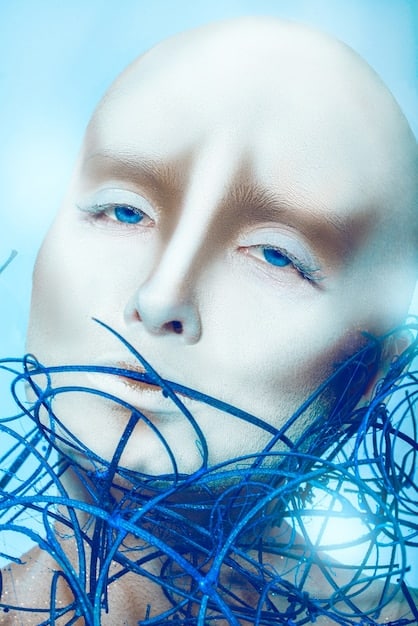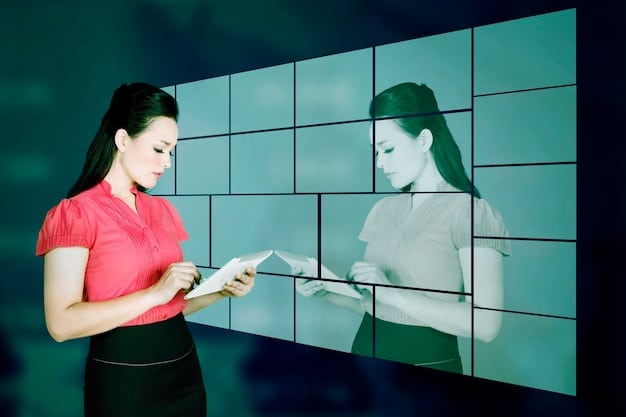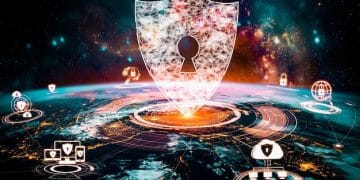The Rise of Deepfakes: Spotting Misinformation and Staying Safe

The rise of deepfakes presents a significant challenge in discerning truth from falsehood online. This article explores how to identify deepfakes and protect yourself from misinformation in an increasingly digital world.
The digital age has brought incredible advancements, but it has also introduced new challenges. One of the most concerning is the rise of deepfakes – manipulated videos and audio recordings that can make it seem as though someone said or did something they never actually did. Understanding how to navigate this landscape is crucial to protect yourself from misinformation.
This article will delve into the world of deepfakes, providing you with the knowledge and tools to spot them and safeguard yourself against their potential harm. Ready to learn how to protect yourself in the age of digital deception?
Understanding the Deepfake Phenomenon
Deepfakes are not just a technological curiosity; they represent a growing threat to individuals, organizations, and even democracy itself. These sophisticated manipulations can erode trust, spread false narratives, and damage reputations. Knowing how these fakes operate is the first step in defending against them.
What Exactly Are Deepfakes?
Deepfakes are created using artificial intelligence (AI), specifically deep learning techniques. This technology allows creators to map one person’s face onto another’s body or manipulate audio to make it sound like someone is saying something they never did. The result is often eerily realistic, making it difficult to distinguish from genuine content.
The History of Deepfakes
The term “deepfake” originated on Reddit in 2017, where users began sharing manipulated videos of celebrities. Since then, the technology has become more accessible and sophisticated. Today, deepfakes can be created with relatively simple software and hardware, making it easier for malicious actors to spread disinformation.
The Potential Dangers of Deepfakes
The dangers of deepfakes are far-reaching. They can be used for:
- Political manipulation: Spreading false information to influence elections or damage political opponents.
- Financial scams: Creating fake endorsements or testimonials to promote fraudulent investments.
- Reputation damage: Fabricating compromising videos or audio recordings to ruin someone’s reputation.
- Cyberbullying: Creating fake videos to harass or humiliate individuals.
- Erosion of trust: Making it harder to believe anything seen or heard online, contributing to societal distrust.

Understanding the technology behind deepfakes and their potential applications is crucial for building resilience against their harmful effects. By staying informed, individuals and organizations can better protect themselves from falling victim to these deceptive tactics.
Techniques for Spotting Deepfakes
While deepfake technology continues to improve, there are still telltale signs that can help you identify manipulated content. By developing a critical eye and using available tools, you can become more adept at spotting these fakes.
Visual Cues to Look For
Several visual cues can indicate that a video or image has been manipulated:
- Unnatural facial movements: Jerky or unnatural movements, especially around the mouth and eyes.
- Blurry or inconsistent lighting: Inconsistencies in lighting or blurry areas on the face or body.
- Asymmetrical features: Noticeable asymmetry in facial features, like uneven eyes or a lopsided smile.
- Lack of blinking: Infrequent or unnatural blinking patterns.
- Pixelation or artifacts: Visible pixelation or digital artifacts, especially around the face.
Audio Clues to Listen For
Audio deepfakes can be more challenging to detect, but there are still clues to listen for:
- Inconsistent tone or pitch: Sudden changes in tone or pitch that don’t match the speaker’s usual voice.
- Background noise inconsistencies: Abrupt changes or unnatural sounds in the background.
- Choppy or robotic speech: Speech that sounds disjointed or robotic.
- Lack of natural pauses: A lack of natural pauses or inflections in speech.
Tools and Technologies for Deepfake Detection
Several tools and technologies can assist in deepfake detection:
- AI-powered detection software: Software that analyzes videos and audio for signs of manipulation.
- Reverse image search: Tools like Google Images that can help you find the original source of an image or video.
- Metadata analysis: Examining the metadata of a file for inconsistencies or signs of tampering.
By combining visual and audio analysis with the help of detection tools, you can significantly improve your ability to identify deepfakes. Staying vigilant and questioning the authenticity of online content is key.

Protecting Yourself from Misinformation
In an era dominated by digital content, protecting yourself from misinformation is paramount. The rise of deepfakes has made this task more complex, but with the right strategies, you can navigate the digital landscape safely.
Developing Critical Thinking Skills
One of the most effective ways to protect yourself from misinformation is to develop strong critical thinking skills. This involves questioning the information you encounter and verifying its authenticity through multiple sources.
Verifying Information Through Multiple Sources
Relying on a single source of information can be risky. Cross-referencing information from multiple reputable sources can help you identify inconsistencies or red flags. Look for sources that are transparent about their funding and editorial policies.
Being Wary of Emotionally Charged Content
Deepfakes and misinformation often exploit emotions to manipulate viewers. Be especially cautious of content that triggers strong emotional reactions, such as anger, fear, or outrage. Take a step back and evaluate the information objectively before sharing it.
Staying Informed About Deepfake Technology
The more you know about deepfake technology, the better equipped you will be to identify and protect yourself from it. Stay updated on the latest deepfake techniques and detection methods by following reputable tech blogs, news sources, and research institutions.
Promoting Media Literacy
Media literacy is the ability to access, analyze, evaluate, and create media. Promoting media literacy among your friends, family, and community can help create a more informed and resilient society. Encourage open discussions about the sources and credibility of online content.
By adopting these strategies, you can significantly reduce your risk of falling victim to deepfakes and misinformation. Staying vigilant, exercising critical thinking, and promoting media literacy are essential in today’s digital world.
The Rise of Deepfakes: Mitigating the Risks
As the rise of deepfakes continues, understanding how to mitigate the risks they pose is critical. From technological solutions to policy interventions, a multi-faceted approach is necessary to combat the spread of deepfake-related misinformation.
Technological Solutions
Technology plays a vital role in both creating and detecting deepfakes. Advancements in AI and machine learning offer potential solutions for identifying manipulated content. Watermarking techniques, for example, can help verify the authenticity of videos and images.
Policy Interventions
Governments and regulatory bodies can play a key role in addressing the rise of deepfakes. Policy interventions may include:
- Legislation: Enacting laws that criminalize the malicious creation and distribution of deepfakes.
- Regulation: Implementing regulations that require social media platforms to detect and remove deepfakes.
- Public awareness campaigns: Launching campaigns to educate the public about the dangers of deepfakes and how to spot them.
Industry Standards
Collaboration among tech companies, media organizations, and research institutions is crucial for developing industry standards related to deepfake detection and prevention. These standards can help ensure that platforms are equipped to handle the challenges posed by deepfakes.
Education and Awareness
Education and awareness initiatives are essential for empowering individuals to protect themselves from the harms of deepfakes. Schools, libraries, and community organizations can offer workshops and resources to promote media literacy and critical thinking skills.
International Cooperation
The rise of deepfakes is a global issue that requires international cooperation. Countries can share best practices, collaborate on research, and coordinate policy responses to address the threat effectively.
By implementing technological solutions, policy interventions, industry standards, education, and international cooperation, we can effectively mitigate the risks associated with deepfakes and protect ourselves from their potential harm.
The Future of Deepfake Detection and Prevention
As deepfake technology continues to evolve, so too must our methods of detection and prevention. The future of deepfake detection will likely involve a combination of AI-driven solutions, human expertise, and proactive measures to verify the authenticity of digital content.
AI-Driven Detection Systems
Artificial intelligence and machine learning will play an increasingly important role in deepfake detection. AI-driven systems can analyze videos and audio in real-time, flagging potentially manipulated content for further review. These systems can also learn from new deepfake examples, improving their accuracy over time.
Human Expertise and Verification
While AI can automate much of the detection process, human expertise will still be needed to verify the authenticity of complex or ambiguous content. Fact-checkers, journalists, and other experts can use their knowledge and skills to investigate and debunk deepfakes. The rise of deepfakes has made their role even more critical.
Blockchain Technology
Blockchain technology offers a potential solution for verifying the authenticity of digital content. By creating a transparent and tamper-proof record of the origin and modifications of a file, blockchain can help ensure that viewers can trust the content they are seeing.
Watermarking and Metadata
Watermarking and metadata techniques can be used to embed information about the origin and authenticity of digital content. These techniques can help viewers verify that a video or image has not been manipulated since it was created.
Proactive Measures
Proactive measures, such as media literacy education and public awareness campaigns, can help prevent the spread of deepfakes and misinformation. By empowering individuals to think critically and question the content they consume, we can create a more resilient society.
The future of deepfake detection and prevention will require a multi-faceted approach that combines technological solutions, human expertise, and proactive measures. By staying informed, investing in research and development, and promoting media literacy, we can effectively combat the threat of deepfakes and protect ourselves from misinformation.
| Key Point | Brief Description |
|---|---|
| 💡 Spotting Visual Cues | Look for unnatural facial movements, lighting inconsistencies, or pixelation. |
| 🎧 Identifying Audio Clues | Listen for inconsistent tone, robotic speech, or unnatural background noise. |
| 🛡️ Protecting Yourself | Develop critical thinking skills and verify information through multiple sources. |
| 🤖 Technological Solutions | Use AI-driven systems and blockchain to detect and verify content. |
Frequently Asked Questions
Deepfakes are manipulated videos or audio clips that use AI to convincingly alter or fabricate content. They are concerning because they can spread misinformation, damage reputations, and erode trust in media.
Signs include unnatural facial movements, inconsistent lighting, blurry areas, asymmetrical features, and a lack of natural blinking. Audio deepfakes may have inconsistent tones or robotic speech.
Develop critical thinking skills, verify information through multiple reputable sources, and be wary of emotionally charged content. Education about the rise of deepfakes is also crucial.
Yes, there are AI-powered detection software, reverse image search tools, and metadata analysis techniques that can help identify manipulated content. These tools are continuously improving.
Efforts include policy interventions, industry standards, and international cooperation. Technological solutions and education and awareness initiatives are also essential components of the fight against deepfakes.
Conclusion
The rise of deepfakes presents a significant challenge to our ability to discern truth from falsehood in the digital age. By staying informed, developing critical thinking skills, and utilizing available tools, we can protect ourselves from the potential harm of these deceptive technologies.
As technology evolves, so too must our methods of detection and prevention. By working together, we can create a more resilient and informed society that is less susceptible to the influence of deepfakes and misinformation.





